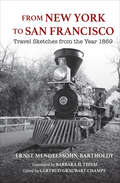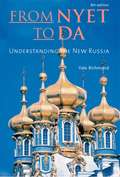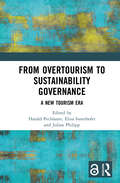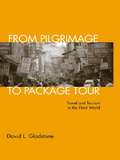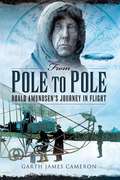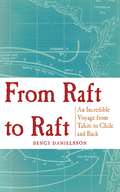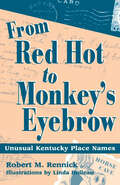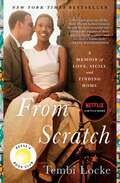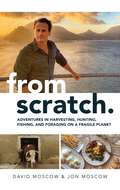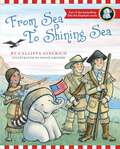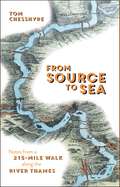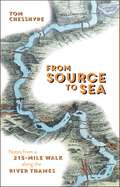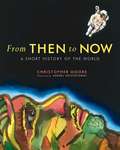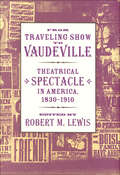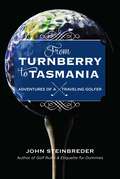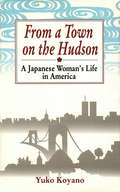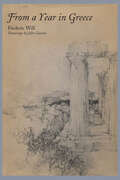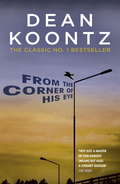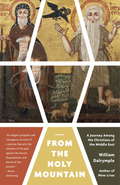- Table View
- List View
From New York to San Francisco: Travel Sketches from the Year 1869 (Encounters: Explorations in Folklore and Ethnomusicology)
by Ernst Mendelssohn-BartholdyA &“fresh, wonderful, captivating&” journey across 19th-century America through the letters of composer Felix Mendelssohn&’s nephew (alfemminile.blogspot.com). Welcome to an America you&’ve never seen. Where anyone can drop by the White House and visit the President between 10 a.m. and noon; where cowcatchers are bloodied daily on train tracks between New York and Boston; where spent bullets are strewn across Civil War battlefields, and Indians still roam Yosemite Valley; where pigs rut in the sand-and-clay streets of Washington, DC., and the weather-bleached skeletons of oxen and horses line the old mail roads across the West. For three hot summer months in 1869, Ernst Mendelssohn-Barthody, the nephew of famed composer Felix Mendelssohn, traveled by train across the United States accompanied by his older cousin. His letters back home to Prussia offer fascinating glimpses of a young, rapidly growing America. Unceasingly annoyed at the Americans&’ tendency to spit all the time, the Prussian aristocrats seemingly visited everyone and everywhere: meeting President Grant and Brigham Young; touring Niagara Falls, Mammoth Cave, the Redwoods, and Yosemite; taking in New York, Boston, Philadelphia, Chicago, Omaha, San Francisco, and the still war-ravaged city of Richmond; and crossing the continent by rail just two months after the Union Pacific and Central Pacific railroads had been joined at Promontory, Utah. Full of marvelous tales and insightful observations, Ernst Mendelssohn-Barthody&’s letters are a revealing window to a long-ago America. &“If you love epistolary genre and the USA and if you want to understand how Americans lived immediately after the Secession War, From New York to San Francisco is the book you were waiting for.&”—alfemminile.blogspot.com
From Nyet To Da: Understanding The New Russia (Interact Ser.)
by Yale RichmondThis classic guide illuminates the dynamics of traditional Russian culture in the framework of contemporary events. Yale Richmond enlightens readers about virtually every aspect of Russian life, covering social and interpersonal skills as well as the underlying cultural assumptions and values of the Russian people. Fully revised and updated, the fourth edition of From Nyet to Da is contemporary and up-to-date with pertinent information about the political, social and economic situations in the New Russia. Business executives, educators, students and government officials alike will gain new insights from this even-handed treatment of the Russian people. Weaving Russian cultural behavior with historical references and modern-day anecdotes, From Nyet to Da makes learning about these interesting and passionate people a fascinating experience.
From Overtourism to Sustainability Governance: A New Tourism Era
by Elisa Innerhofer Harald Pechlaner Julian PhilippInsightful and international in scope, this significant volume explores the transition from overtourism to sustainability governance and elaborates perspectives for developing resilient destinations.The book is split into three parts and comprises interdisciplinary contributions from renowned authors and scholars in the field, with each part including case studies to illustrate real-world applications of the topics and issues discussed. Part I provides an overview of current academic discussion on overtourism, presents theoretical concepts and illustrates the impact of the COVID-19 pandemic, as well as the development from overtourism to no-tourism. Part II discusses approaches towards a new sustainability through the lens of current research and future trends, including a possible new understanding of tourism in a post-pandemic world. Part III presents strategies to deal with overtourism, including management strategies and governance theories. Equipped with a wide range of examples and insights from across the globe, the book is intended to facilitate the ongoing journey towards a more sustainable tourism industry, that is increasingly resilient and less vulnerable to crises.This will be of pivotal interest to academics, researchers and practitioners in the fields of tourism, over- and mass-tourism, as well as sustainability governance.The Open Access version of this book, available at http://www.taylorfrancis.com, has been made available under a Creative Commons [Attribution-Non Commercial-No Derivatives (CC-BY-NC-ND)] 4.0 license.
From Pilgrimage to Package Tour: Travel and Tourism in the Third World
by David L. GladstoneWhen people in First World countries think of tourists in the vast expanses of the Third World today, they typically think of pampered westerners, filling up the luxury hotels and imposing their Orientalist gazes on the teeming masses. As David Gladstone shows us in this fascinating and provocative book, such preconceptions are wrong. Coupling incisive and colorful ethnographic accounts of tourism in India and Mexico with sharp analysis, Gladstone demonstrates the amazing complexity of this industry, which now comprises close to ten percent of the world economy. As he also shows, the vast majority of tourists in the Third World are indigenous people with few resources-often making pilgrimages to religious shrines.From Pilgrimage to Package Tour is a fresh and entirely original account that stands tourism studies on its head and proves that this industry is far more complicated than it initially appears.
From Pole to Pole: Roald Amundsen?s Journey in Flight
by Garth James CameronRoald Amundsen was the most successful polar explorer of his era using sledges, dogs, skis, and ships. He is mainly remembered for being the first man to reach the South Pole on December 14, 1911. What is less often remembered is that he was also the first man to reach the North Pole on May 12, 1926, as the leader of the Amundsen-Ellsworth-Nobile expedition in the airship Norge. His involvement in aviation from his experiments with man-lifting kites in 1909 to his death in 1928 while flying from Norway to Spitsbergen has not been the subject of a detailed study until now.From Pole to Pole explores Amundsen's enthusiasm for flight from the moment he read about Blériot's flight across the English Channel in an airplane. In June 1928 Amundsen and five companions took off in a search and rescue flight for the missing airship Italia and were never seen again. The only traces of the men and their aircraft were a tip float and an empty fuel tank which washed up on the coast of northern Norway several months later. Searches of the seabed near Bear Island for the remains of the Latham 47 flying boat he was flying in took place in 2004 and 2009, and interest in the mystery of his disappearance remains high.
From Pompeii
by Ingrid D. RowlandWhen Vesuvius erupted in 79 CE, the force of the explosion blew the top right off the mountain, burying nearby Pompeii in a shower of volcanic ash. Ironically, the calamity that proved so lethal for Pompeii's inhabitants preserved the city for centuries, leaving behind a snapshot of Roman daily life that has captured the imagination of generations. The experience of Pompeii always reflects a particular time and sensibility, says Ingrid Rowland. From Pompeii: The Afterlife of a Roman Town explores the fascinating variety of these different experiences, as described by the artists, writers, actors, and others who have toured the excavated site. The city's houses, temples, gardens--and traces of Vesuvius's human victims--have elicited responses ranging from awe to embarrassment, with shifting cultural tastes playing an important role. The erotic frescoes that appalled eighteenth-century viewers inspired Renoir to change the way he painted. For Freud, visiting Pompeii was as therapeutic as a session of psychoanalysis. Crown Prince Hirohito, arriving in the Bay of Naples by battleship, found Pompeii interesting, but Vesuvius, to his eyes, was just an ugly version of Mount Fuji. Rowland treats readers to the distinctive, often quirky responses of visitors ranging from Wolfgang Amadeus Mozart, Charles Dickens, and Mark Twain to Roberto Rossellini and Ingrid Bergman. Interwoven throughout a narrative lush with detail and insight is the thread of Rowland's own impressions of Pompeii, where she has returned many times since first visiting in 1962.
From Raft to Raft: An Incredible Voyage from Tahiti to Chile and Back
by Bengt DanielssonNot since the fantastic story of the Kon-Tiki expedition has there appeared such as exciting saga of a primitive raft expedition across the Pacific for scientific investigation. <P><P> From Raft to Raft tells the incredible, suspenseful drama of the dangerous voyage led by Eric de Bisschop from Tahiti to Chile and back to Polynesia--a foray twice as long as that undertaken by Kon-Tiki and one that encountered infinitely greater difficulties and dangers.Like Heyerdahl, de Bisschop undertook his voyage to prove an ethnological theory--but a theory completely contrary to that of his Norwegian forerunner. Heyerdahl believed that voyagers from South America had visited Polynesia in prehistoric times; de Bisschop was equally certain that Tahitian sea rovers had traveled as far as Chile and Peru.<P> After suffering unbelievable hardships during the first half of the voyage, two members of the Tahiti Nui crew abandoned the project, but de Bisschop and Alain Brun, who narrated the story to Bengt Danielsson, continued on their journey, spending thirteen months aboard the most primitive rafts. But despite the inadequacy of their crafts--all of which had a frightening tendency to break up--coupled with the dangers of attacking sharks, mutiny by one of the crew, raging storms, and near-starvation, the Tahiti Nui voyage was completed in record time--but not before a series of dramatic events occurred that were to culminate in tragic death
From Red Hot to Monkey's Eyebrow: Unusual Kentucky Place Names
by Robert M. RennickYou can find Paradise in Kentucky—along with many other quirky place names, and the truth (and tall tales) behind them . . .Encountering some of the uncommon geographical names in the Commonwealth of Kentucky for the first time, visitors and residents alike often assume that some clever or funny stories lie behind them. So they ask, how did Elkhorn Creek get its name? Were the roads to Red River really Hell each way? Did bugs really tussle in Monroe County? Why was everyone whooping for Larry?To be hospitable and helpful, Kentuckians have come up with convincing?if not always truthful?answers to these and other questions about how places got their names. Some of these stories were clearly not intended to be believed, though a few of them have been anyway. From Red Hot to Monkey’s Eyebrow presents some of the classic accounts of Kentucky’s oddest place names. Complete with map, index, and humorous drawings by Linda Boileau, this handy guide is a geography lover’s delight.
From Reindeer Lake to Eskimo Point
by Peter Kazaks George LusteCanoe across large lakes, up and down rivers and rapids; labour over portages and through a miasma of blackflies; bask in the golden evenings of the Subarctic. In this account of an 800-mile canoe trip – which begins at Reindeer Lake on the Manitoba/Saskatchewan border, continues into Nunavut past the treeline, and ends on Hudson Bay – Peter Kazaks conveys the experience of being in the north by describing the daily details that bring the trip to life. He captures the flavour of an extended wilderness canoe trip and reflects on living in unfettered wilderness. The reader will also grasp something of the serene beauty of the barren lands and begin to understand why its intoxicating nature keeps drawing some back. The first half of the trip, essentially from Reindeer Lake to Nueltin Lake, retraces P.G. Downes’ voyage described in his classic Sleeping Island. Next the four men of this expedition, led by George Luste, entered the barren lands and followed the Thlewiaza River, the Kognak River, South Henik Lake and the Maguse River north and east to the shore of Hudson Bay. These lands, seldom visited, are close to a true wilderness – one of the few remaining ones.
From Rocky Waters to a Smooth Finish: Neal Petersen's Story (Fountas & Pinnell LLI Purple #Level S)
by Helen ScullyBorn dark-skinned in South Africa and with a missing hip joint, Neal Petersen faced many challenges to achieve his dream of sailing around the world.
From Scratch: A Memoir of Love, Sicily, and Finding Home
by Tembi LockeNow a limited Netflix series starring Zoe Saldaña! This Reese Witherspoon Book Club Pick and New York Times bestseller is &“a captivating story of love lost and found&” (Kirkus Reviews) set in the lush Sicilian countryside, where one woman discovers the healing powers of food, family, and unexpected grace in her darkest hours.It was love at first sight when actress Tembi met professional chef, Saro, on a street in Florence. There was just one problem: Saro&’s traditional Sicilian family did not approve of his marrying a black American woman. However, the couple, heartbroken but undeterred, forged on. They built a happy life in Los Angeles, with fulfilling careers, deep friendships, and the love of their lives: a baby girl they adopted at birth. Eventually, they reconciled with Saro&’s family just as he faced a formidable cancer that would consume all their dreams. From Scratch chronicles three summers Tembi spends in Sicily with her daughter, Zoela, as she begins to piece together a life without her husband in his tiny hometown hamlet of farmers. Where once Tembi was estranged from Saro&’s family, now she finds solace and nourishment—literally and spiritually—at her mother-in-law&’s table. In the Sicilian countryside, she discovers the healing gifts of simple fresh food, the embrace of a close knit community, and timeless traditions and wisdom that light a path forward. All along the way she reflects on her and Saro&’s romance—an incredible love story that leaps off the pages. In Sicily, it is said that every story begins with a marriage or a death—in Tembi Locke&’s case, it is both. &“Locke&’s raw and heartfelt memoir will uplift readers suffering from the loss of their own loved ones&” (Publishers Weekly), but her story is also about love, finding a home, and chasing flavor as an act of remembrance. From Scratch is for anyone who has dared to reach for big love, fought for what mattered most, and those who needed a powerful reminder that life is...delicious.
From Scratch: Adventures in Harvesting, Hunting, Fishing, and Foraging on a Fragile Planet
by David Moscow Jon MoscowDavid Moscow, the creator and star of the groundbreaking series From Scratch, takes us on an exploration of our planet&’s complex and interconnected food supply, showing us where our food comes from and why it matters in his new book of global culinary adventures.In an effort to help us reconnect with the food that sustains our lives, David Moscow has spent four years going around the world, meeting with rock-star chefs, and sourcing ingredients within local food ecosystems—experiences taking place in over twenty countries that include milking a water buffalo to make mozzarella for pizza in Italy; harvesting oysters in Long Island Sound and honey from wild bees in Kenya; and making patis in the Philippines, beer in Malta, and sea salt in Iceland. Moscow takes us on deep dives (sometimes literally) with fisherfolk, farmers, scientists, community activists, historians, hunters, and more, bringing back stories of the communities, workers, and environments involved—some thriving, some in jeopardy, all interconnected with food. The result is this travel journal that marvels in the world around us while simultaneously examining the environmental issues, cultural concerns, and overlooked histories intertwined with the food we eat to survive and thrive. Through the people who harvest, hunt, fish, and forage each day, we come to understand today&’s reality and tomorrow&’s risks and possibilities.
From Sea to Shining Sea
by Callista Gingrich Susan ArcieroEllis the Elephant is back and ready for another adventure in American history! In From Sea to Shining Sea, the fourth installment of Callista Gingrich’s New York Times bestselling series, Ellis explores the early years of the United States and heads west into uncharted territory with Lewis and Clark.In previous books, Sweet Land of Liberty, Land of the Pilgrims’ Pride, and Yankee Doodle Dandy, Ellis learned about pivotal moments that have shaped America. Now, in From Sea to Shining Sea, America’s favorite time-traveling pachyderm discovers a new and growing nation along with George Washington, Thomas Jefferson, Lewis and Clark, Sacagawea and others.Authored by Callista Gingrich and illustrated by Susan Arciero, From Sea to Shining Sea will delight those who want to know how brave Americans forged a growing nation and spread freedom from coast to coast.
From Source to Sea: Notes from a 215-Mile Walk Along the River Thames
by Tom ChesshyreAuthors, artists and amblers have always felt the pull of the Thames, and now Tom Chesshyre is following in their footsteps. He’s walking more than 200 miles from the Cotswolds to the North Sea. Seeing some familiar sights through new eyes, Chesshyre explores the living present and remarkable past of England’s longest and most iconic river.
From Source to Sea: Notes from a 215-Mile Walk Along the River Thames
by Tom ChesshyreAuthors, artists and amblers have always felt the pull of the Thames, and now Tom Chesshyre is following in their footsteps. He’s walking more than 200 miles from the Cotswolds to the North Sea. Seeing some familiar sights through new eyes, Chesshyre explores the living present and remarkable past of England’s longest and most iconic river.
From Source to Sea: Notes from a 215-Mile Walk Along the River Thames
by Tom ChesshyreAuthors, artists and amblers have always felt the pull of the Thames, and now Tom Chesshyre is following in their footsteps. He’s walking more than 200 miles from the Cotswolds to the North Sea. Seeing some familiar sights through new eyes, Chesshyre explores the living present and remarkable past of England’s longest and most iconic river.
From Source to Sea: Notes from a 215-Mile Walk Along the River Thames
by Tom ChesshyreAuthors, artists and amblers have always felt the pull of the Thames, and now Tom Chesshyre is following in their footsteps. He’s walking more than 200 miles from the Cotswolds to the North Sea. Seeing some familiar sights through new eyes, Chesshyre explores the living present and remarkable past of England’s longest and most iconic river.
From Then to Now: A Short History of the World
by Christopher MooreTraces human civilization from early bands of hunter-gatherers to the multicultural world cities of the present, covering the development of agriculture, empires, law, and the major religions, the rise of Europe, colonies, and industrialization.
From Traveling Show to Vaudeville: Theatrical Spectacle in America, 1830–1910
by Robert M. LewisBefore phonographs and moving pictures, live performances dominated American popular entertainment. Carnivals, circuses, dioramas, magicians, mechanical marvels, musicians, and theatrical troupes—all visited rural fairgrounds, small-town opera houses, and big-city palaces around the country, giving millions of people an escape from their everyday lives for a dime or a quarter. In From Traveling Show to Vaudeville, Robert M. Lewis has assembled a remarkable collection of nineteenth- and early twentieth-century primary sources that document America's age of theatrical spectacle. In eight parts, Lewis explores, in turn, dime museums, minstrelsy, circuses, melodramas, burlesque shows, Wild West shows, amusement parks, and vaudeville.Included in this compendium are biographies, programs, ephemera produced by theatrical entrepreneurs to lure audiences to their shows, photographs, scripts, and song lyrics as well as newspaper accounts, reviews, and interviews with such figures as P. T. Barnum and Buffalo Bill Cody. Lewis also gives us reminiscences about and reactions to various shows by members of audiences, including such prominent writers as Mark Twain, William Dean Howells, Nathaniel Hawthorne, Carl Sandburg, Walt Whitman, Louisa May Alcott, Charles Dickens, O. Henry, and Maxim Gorky. Each section also includes a concise introduction that places the genre of spectacle into its historical and cultural context and suggests major interpretive themes. The book closes with a bibliographic essay that identifies relevant scholarly works.Many of the pieces collected here have not been published since their first appearance, making From Traveling Show to Vaudeville an indispensable resource for historians of popular culture, theater, and nineteenth-century American society.
From Turnberry to Tasmania: Adventures of a Traveling Golfer
by John SteinbrederFrom Turnberry to Tasmania is an invitation to travel with award-winning journalist John Steinbreder on a global golf trek. From putting alongside tawny wallabies and blue-tongued lizards in Tasmania to literary pub crawls in Dublin after rounds at nearby links, this book contains remarkable golf adventures from Steinbreder&’s nearly two decades of tee-time wanderlust.
From a Town on the Hudson
by Yuko KoyanoYuko Koyano spent five years in the United States in the 1980s as the wife of a Japanese businessman, the mother of two sons, and an observer in her own right. She believed that the experience would open a new window on the world for herself and her family, and she was not disappointed. From the outset, Ms. Koyano was a keen observer of American life in the New Jersey town where she lived just across the Hudson from Manhattan. She soon found that her study of English Literature in college in Japan had left her ill-prepared to understand the words in her sons' schoolbooks, not to mention the ones they picked up even more quickly in the schoolyard. Nor did contemporary life in the United States match the images she had grown up with on Japanese television reruns of American sitcoms. Not deterred, Ms. Koyano entered the life of everyday America, and its cast of characters-schoolteachers, senior citizens, taxi drivers, police officers, and postal clerks-fill the pages of this affectionate memoir. The vignettes captured in From a Town on the Hudson delight, amuse, and touch the reader, and give us-host and visitor alike-an opportunity to see ourselves as others see us.
From a Year in Greece
by Frederic WillIn this book, the reader is privileged to take a leisurely and thoroughly enjoyable trip through the Greece of the mid-twentieth century, led by a poet-narrator who is a comfortable and engaging guide and complemented by the artwork of John Guerin. Frederic Will recounts his odyssey: from Austria through Yugoslavia, across the northern Greek border, from Salonika to Athens and the Aegean Sea, to the site of remnants of Old Greece in Smyrna, Pergamum, and Ephesus, and finally to the monasteries on Mount Athos. The author not only presents vivid descriptions of the towns and people in contemporary Greece but also conveys the still-present aura of the ancient Greek deities, in both the ruins and the modern cities. Witness the following passage written at Salonika, in Northern Greece, Will’s first stop of importance: The sense-binding, sense-shaping ocean is omnipresent there. It is visible from nearly any point in the city. You only need to go up to your second story—if you have one. There is that pure, rhythmic, bounded but boundless element, spread somewhere at the bottom of the street. The same vision glimmers or stirs at the end of nearly every east-west-running street. Many townsmen spend much of their time promenading along the harbor. They seem to be subliminally magnetized to the sea. I spent several weeks there. During that time I would often go up to the crowning Venetian walls, and look down onto Salonika and its harbor. From there Salonika’s deep dependence on the ocean became a fact proved by eyesight. The city is built on the half-moon-shaped plain of the Axios River. Two images came to me repeatedly: that Salonika is an amphitheater facing the ocean; or that she is a lover, reaching to embrace the ocean. Here are the hot, white (or cream-colored) buildings of the city; there is the element they thirst for. Will gives a great deal of fascinating information but gives it gracefully and without excess. Above all, the narrative is suffused with the atmosphere, the emotions, and the beauty of Greece. The author has said he intends for this work to dramatize, not to instruct. Actually, it does both.
From a Year in Greece
by Frederic WillIn this book, the reader is privileged to take a leisurely and thoroughly enjoyable trip through the Greece of the mid-twentieth century, led by a poet-narrator who is a comfortable and engaging guide and complemented by the artwork of John Guerin. Frederic Will recounts his odyssey: from Austria through Yugoslavia, across the northern Greek border, from Salonika to Athens and the Aegean Sea, to the site of remnants of Old Greece in Smyrna, Pergamum, and Ephesus, and finally to the monasteries on Mount Athos. The author not only presents vivid descriptions of the towns and people in contemporary Greece but also conveys the still-present aura of the ancient Greek deities, in both the ruins and the modern cities. Witness the following passage written at Salonika, in Northern Greece, Will’s first stop of importance: The sense-binding, sense-shaping ocean is omnipresent there. It is visible from nearly any point in the city. You only need to go up to your second story—if you have one. There is that pure, rhythmic, bounded but boundless element, spread somewhere at the bottom of the street. The same vision glimmers or stirs at the end of nearly every east-west-running street. Many townsmen spend much of their time promenading along the harbor. They seem to be subliminally magnetized to the sea. I spent several weeks there. During that time I would often go up to the crowning Venetian walls, and look down onto Salonika and its harbor. From there Salonika’s deep dependence on the ocean became a fact proved by eyesight. The city is built on the half-moon-shaped plain of the Axios River. Two images came to me repeatedly: that Salonika is an amphitheater facing the ocean; or that she is a lover, reaching to embrace the ocean. Here are the hot, white (or cream-colored) buildings of the city; there is the element they thirst for. Will gives a great deal of fascinating information but gives it gracefully and without excess. Above all, the narrative is suffused with the atmosphere, the emotions, and the beauty of Greece. The author has said he intends for this work to dramatize, not to instruct. Actually, it does both.
From the Corner of his Eye: A breath-taking thriller of mystical suspense and terror
by Dean KoontzAll he wanted was to make his mother proud... Dean Koontz's From the Corner of His Eye is an unforgettable thriller of suspense, danger and the supernatural. Perfect for fans of Stephen King and Richard Laymon.'A wonderful read. The pacing is perfect, keeping the reader in exquisite tension. This is a deeply satisfying, rich novel. You may have nightmares about [the villain] but you'll love the other characters. Singularly and collectively, they are unforgettable. From the Corner of His Eye is magic' - New Orleans Times-PicayuneBartholomew Lampion was blinded at the age of three, when surgeons reluctantly removed his eyes to save him from a fast-spreading cancer. But although eyeless, Barty regained his sight when he was thirteen.This sudden ascent from a decade of darkness into the glory of light was not brought about by a holy healer. No celestial trumpets announced the restoration of his vision, just as none had announced his birth.A rollercoaster had something to do with his recovery, as did a seagull. And you can't discount Barty's profound desire to make his mother proud of him before she died.The first time she died was the day Barty was born. January 6, 1965. What readers are saying about From the Corner of His Eye: 'At one stage I was so shocked by what happened I had to reread a few pages to make sure I hadn't misread... the twist was so surprising and so unexpected''This book had twists and turns to the last word''One of the best books I've ever read'
From the Holy Mountain
by William DalrympleIn the spring of A.D. 587, John Moschos and his pupil Sophronius the Sophist embarked on a remarkable expedition across the entire Byzantine world, traveling from the shores of Bosphorus to the sand dunes of Egypt. Using Moschos's writings as his guide and inspiration, the acclaimed travel writer William Dalrymple retraces the footsteps of these two monks, providing along the way a moving elegy to the slowly dying civilization of Eastern Christianity and to the people who are struggling to keep its flame alive. The result is Dalrymple's unsurpassed masterpiece: a beautifully written travelogue, at once rich and scholarly, moving and courageous, overflowing with vivid characters and hugely topical insights into the history, spirituality and the fractured politics of the Middle East.
